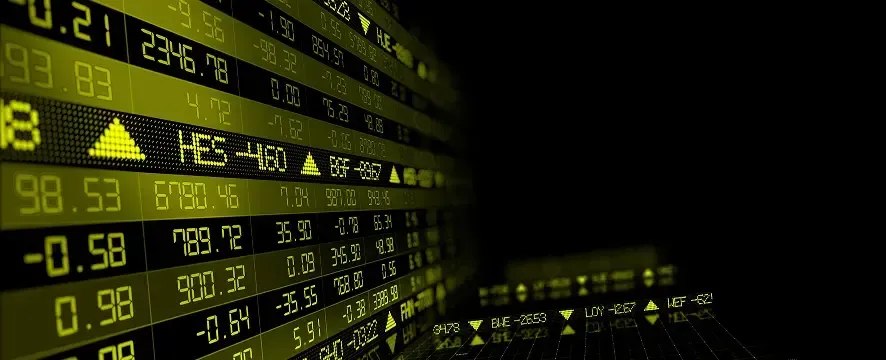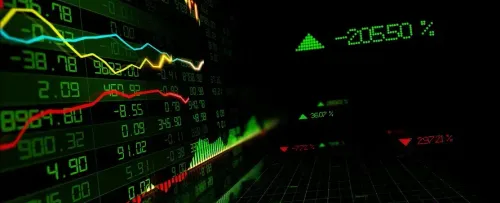
A forex spread is the gap between two prices that forex traders will see when trading currencies—the price you can sell at (bid) and the price you can buy at (ask). This gap is essentially what you pay as a trading fee every time you enter a trade.
The lower your spread costs, the more of your profits you get to keep.
This is where the choice of the right broker becomes useful. SeacrestMarkets, for example, offers some of the tightest spreads in the market, with prices starting from as low as 0.0 pips. For traders who place dozens of trades in a day or week, these savings can truly accumulate over the long term.
Introduction to the Forex Market
The forex market—short for foreign exchange, is where the world trades currencies. It's actually the world's biggest financial market, with more money changing hands here than anywhere else in the world.
Consider it as a gigantic, round-the-clock marketplace in which individuals, firms, and financial institutions all over the world gather to exchange one currency for another. Whether it is a South African firm purchasing US dollars to cover imports, or a vacationer exchanging rands for euros in advance of a trip to Europe, they do it on the forex market.
Forex trading is all about currency pairs—you're always selling one currency and buying another simultaneously. As an example, if you think that the euro will strengthen compared to the US dollar, you'd sell dollars and purchase euros. If you're right and the euro strengthens compared to the dollar, you get to keep the difference.
That's why spreads matter so much: every time you enter a trade, you're automatically "in the red" by the amount of the spread. You need the market to move in your favor by at least that amount to break even. With larger spreads, it becomes more challenging to make a profit.
Understanding Forex Spreads
The spread in forex is the difference between the buy and sell price (bid and ask) in currency trading, and it represents a key trading cost that directly impacts your profitability, potentially leading to lower transaction costs. This is what brokers usually pocket.
Let’s break it down with an example:
Say the EUR/USD is quoted at 1.0850/1.0852. In this case, 1.0850 is the bid price (the price you can sell at), and 1.0852 is the ask price (the price you can buy at). The difference between the two—the spread—is 2 pips.
Now, if you’re trading one standard lot (which is 100,000 units of the base currency), each pip is worth $10. So, a 2-pip spread means you’re paying $20 in trading costs—just to enter the trade, before any profit or loss occurs.
Different forex spread types are measured in pips, typically the fourth decimal of a quote (except for JPY pairs). Some brokers go further by showing a fifth decimal called a pipette, which can make spreads appear smaller than they are.
Forex brokers make money from the spread by setting the buy and sell price for each currency pair. The market price of a currency pair is between the buy and sell prices, and spreads can vary depending on the overall market conditions and the broker’s pricing model.
Market liquidity plays a massive role. Generally, the higher the liquidity, the tighter the spread. For example, commonly traded and highly liquid pairs like EUR/USD or USD/JPY tend to have much tighter spreads than less common, exotic pairs like USD/ZAR. This is because of lower trading volumes and higher risk in these pairs.
Currency Pairs and Spreads
In forex trading, all transactions involve currency pairs, and each currency pair consists of a base currency (the first currency listed) and a counter currency (the second currency listed).
The exchange rate tells you how much of the counter currency is needed to buy one unit of the base currency. Forex spreads, also known as bid-ask spreads, represent the difference between the price at which you can sell (bid price) and the price at which you can buy (ask price) the base currency.
For example, if the EUR/USD currency pair is quoted with a bid price of 1.1000 and an ask price of 1.1002, the spread is 0.0002, or 2 pips.
Major currency pairs like EUR/USD, USD/JPY, and GBP/USD typically offer the tightest spreads due to high market liquidity and trading volume. However, during periods of high market volatility or lower trading volumes, spreads can widen significantly, increasing your immediate trading costs.
As an experienced trader, it’s crucial to monitor market conditions and adjust your trading strategy to account for spread changes, especially when trading different currency pairs or during economic events that can impact the forex markets.
By staying aware of how spreads fluctuate, you can better manage your trading costs and optimize your approach to trading forex.

Types of Forex Spreads
Fixed Spreads vs Floating Spreads
-
A fixed spread remains constant regardless of market conditions or volatility. This predictability can help with planning, as traders always know the cost per trade, but a fixed spread may include hidden costs or delays (such as requotes or slippage) during turbulent market conditions.
-
A variable spread (or variable spreads) fluctuates in real time based on market volatility and liquidity. Unlike a fixed spread, a variable spread can shrink dramatically during quiet sessions—even down to 0.0 pips—but during periods of high volatility or major news events, variable spreads can widen quickly, increasing trading costs.
Raw ECN Spreads and Commission-Based Pricing
With ECN (Electronic Communications Network) accounts like those at SeacrestMarkets, you’re accessing the raw market with spreads starting at 0.0 pips. ECN accounts connect traders directly to liquidity providers, who facilitate trades and help determine the spreads offered. Instead of a markup, you pay a fixed commission per lot—often more transparent and cheaper for active traders.
Spread Markups
Some brokers bake their fees into the spread. Brokers buy and sell the same asset (such as a currency pair) at different prices, and the difference between these prices is called the spread. That’s where standard spreads come in—they appear commission-free but can be 2x or 3x wider than raw pricing.
Factors Affecting Forex Spreads
1. Market Liquidity & Trading Volume
During high-volume periods, especially with major currency pairs, competition tightens spreads. Major pairs and the most traded forex pairs typically have the tightest spreads due to their high liquidity. But if fewer people are trading, spreads widen due to a lack of market depth.
2. Market Sessions
Forex is global, and different market sessions (Tokyo, London, New York) have different liquidity levels. The opening and closing times of major financial markets around the world influence liquidity and spread costs, making certain periods more favorable for trading. For South Africans, 14:00–18:00 SAST (London–New York overlap) often sees lower spreads due to high participation.
3. Economic News & Events
Big data releases, such as economic announcements (job numbers and interest rate changes), cause high volatility in the market. During periods of high volatility around economic announcements, brokers protect themselves by widening spreads, sometimes minutes before the announcement.
4. Broker Pricing Model
Some brokers offer fixed spreads, others use floating spread models. ECN and no-dealing-desk setups (like SeacrestMarkets) typically offer more transparent pricing.
When Forex Spreads Widen (And Why It Matters)
Why Do Forex Spreads Widen at 10 PM?
At around 22:00 SAST, New York trading winds down, and Tokyo hasn’t opened. This low liquidity window causes spreads to widen, sometimes drastically. It’s often best to avoid trading during this “twilight zone.”
Weekend Gaps
Since the forex market is closed from Friday evening to Sunday night, anything that happens over the weekend (like political news or natural disasters) can cause spreads to widen dramatically when markets reopen.
News Trading
Expect spread expansion 10–15 minutes before big news drops. Spread expansion during news events increases the immediate cost of entering or exiting trades. Some brokers widen spreads early to manage risk—which can mess with pending orders and tight stop losses.
Holiday Periods
During times like Christmas or New Year, institutional traders step back, leaving the market to retail traders. The result? Wider spreads and erratic price action.
How to Choose Low-Spread Brokers in South Africa
1. Don't Just Compare Spreads
A broker with 0.1-pip spreads but poor execution can cost more than one offering 1-pip spreads with reliable fills. A lower spread generally results in better trading conditions and reduced costs, especially for strategies sensitive to transaction expenses. SeacrestMarkets offers super-fast execution speeds with a 99.8% fill rate.
2. Look Beyond the Spread
Check for:
-
Slippage during volatility
-
Hidden fees (e.g., withdrawal or inactivity charges)
-
Requotes
3. FSCA Regulation
Choose brokers licensed by South Africa’s FSCA. This ensures client funds are segregated, dispute mechanisms exist, and trading is conducted fairly.
4. Platform and Tech
Look for reliable trading platforms that allow you to enter and exit positions without worrying about whether or not the trading platform will let you down when you need speed of execution and reliability.
Spread Considerations and Forex Trading
Although spreads are important no matter the trading style, here’s how they impact each trading style in more detail:
Scalping
Scalpers target small moves—scalping strategies aim to profit from small price movements and minimal price movements in the market—so tight spreads are non-negotiable for trading success. Scalping is a high-risk strategy that requires discipline and advanced skills.
Anything above 1 pip eats into razor-thin margins. Spreads from 0.0–0.5 pips are ideal, and low spreads are especially important for scalpers to maximize profitability.
Day Trading
More forgiving than scalping, but lower spreads still improve profitability. If you're an active day trader executing 20–30 trades daily, you can save thousands per year with lower spreads, especially by timing your entry and exit during periods of low spreads to further reduce costs.
Swing and Position Trading
Here, spreads are less critical. Traders aiming for 100+ pip moves focus more on overnight swap rates and long-term fundamentals than entry costs, and thorough investment research is essential for successful swing and position trading.
Cost Example in ZAR
A 2-pip spread on one standard lot of EUR/USD equals $20—roughly R380. Spreads are a key component of overall transaction costs in forex trading.
If you trade 50 times monthly without considering other costs, that’s R19,000/month in spread costs and could lead to losing money rapidly. Reducing your average spread by even 1 pip can save you a lot of money.
The SeacrestMarkets Advantage
Live Spread Comparison Widget
SeacrestMarkets lets you monitor spread costs in real-time, so you’ll always have visibility on what your costs are—whether you’re engaging in forex trading or spread bets.
ECN Account Benefits
An ECN account allows traders to access institutional-grade liquidity with no dealing desk.
This allows for faster trade execution and minimal slippage. Therefore, these accounts are particularly good for traders seeking the best pricing and execution on their trades.
FSCA-Licensed Safety
SeacrestMarkets offers South African residents the protection that comes with being regulated by the FSCA.
No Dealing Desk Model
Your trades go straight to the market, not against the broker. This removes the potential for a conflict of interest and ensures unbiased execution.
How Much Do Spreads Actually Cost You?
To understand the real cost of spreads on trading, it’s important to look at real numbers.
Lot Sizes and Pip Values
In forex trading, positions are sized using "lots"—and the size of the lot directly affects how much each pip movement is worth.
-
Standard lot (100,000 units): Each pip equals $10
-
Mini lot (10,000 units): Each pip equals $1
-
Micro lot (1,000 units): Each pip equals $0.10
Note: Japanese yen pairs use different pip calculations, where one pip equals 0.01 rather than 0.0001, affecting the pip value accordingly.
Real-World Cost Analysis
Suppose you're buying and selling EUR/USD with a 2-pip spread in a standard lot. It goes like this:
Per Trade Cost: $20 (about R380)
Monthly Impact: Trading 50 times a month adds up to R19,000 a year in spread charges alone
Account Impact: With a R10,000 starting balance, you're paying nearly 4% of your entire account value on spreads each year—before accounting for commissions, overnight financing charges, or slippage.
The Cumulative Effect
These costs add up over a period of time. A trader who reduces their average spread by just 1 pip is able to trim R9,500+ a year spent on the same frequency of trading. This indicates how selecting a broker providing competitive spreads, like SeacrestMarkets at 0.0 pips, becomes key to keeping profitability intact.
Break-Even Point
If your spread is 2 pips, your trade needs to move 2 pips just to break even. Add commissions, and the target might be 3–4 pips.
Getting Started With Low-Spread Forex Trading
-
Choose the right account: ECN accounts are most suitable for large volume traders. The charges are worth it if you are executing 10+ trades/month. Use demo accounts:_ Test spread behavior under conditions of volatility or news.
-
Match your trading plan: If you are a scalper, you need non-negotiable tight spreads. However, if you are a swing trader, you can tolerate trading instruments with less liquidity.
-
Use tight risk management: If you're trading tight spreads, don't be tempted to overtrade or neglect position-sizing rules.
-
Stay informed: Watch the news and keep up to date on upcoming events and the economic calendar.
Final Thoughts for South African Traders
Forex spread cost understanding and management are hallmarks of long-term profitability. Make certain that your forex broker has tight, transparent pricing, such as SeacrestMarkets. This will considerably lower trading costs.
Most importantly, take your time to learn how spreads work—not just in theory, but practically through trading and using demo accounts.
Take time to learn how spread bets and spreads work—not just in theory, but practically as well, through the use of demo accounts and live trading—it will benefit your bottom line.




